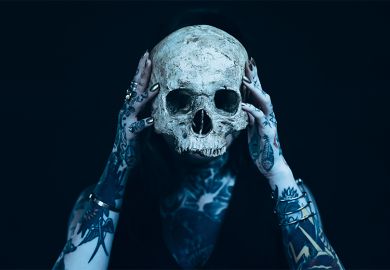Eyes - and nothing more. Eyes - and everything else. Everything else was very little: practically nothing at all." Thus was Mikhail Kuzmin memorably evoked by Marina Tsvetaeva after their meeting in St Petersburg in 1916.
Kuzmin certainly cut a striking figure. In his early phase, he donned the traditional Russian dress of the Old Believers, complete with long beard and heavy boots - but with the addition of eye shadow and scent, so that to Alexey Remizov he resembled either Tutankhamun or a fugitive from a bonfire, who nevertheless smelled like an icon on a feast day. It was a rather unusual costume for one so cosmopolitan and erudite. Kuzmin then cut off his beard and became an aesthete, with a brightly coloured waistcoat for every day of the year, and the occasional beauty spot. Only when it came to going outside with a heart glued near to his eye, a half-moon and star on his cheek and a small phallus behind his ear did Kuzmin draw the line ("too voyantes"). This remarkable biography is full of piquant details about the strange writer-musician with the un-Russian physiognomy and the physique of a faun from a Pompeian fresco, and none of them frivolous. Not only was such flamboyance consonant with the Symbolist proclivity for transforming life into art at the turn of the century, but Kuzmin's relish in changing his sartorial identity so dramatically speaks to his unwavering need to establish a stance of independence from the many heterogeneous artistic groups he was associated with as well as his own eclectic tastes.
If there was one group with whom Kuzmin identified, it was the "World of Art", many of whose members were also openly gay. Kuzmin formed a particularly close association with Walter Nouvel, at whose "evenings of contemporary music" he made his debut in 1905, by performing his own piano and vocal cycle "Alexandrian Songs". A year later he caused a sensation with the publication of his novella Wings, the first work of Russian literature with an explicit homosexual theme, which brought him the sobriquet the "northern Wilde". Kuzmin continued to write both music and prose, and later was to achieve prominence also as a critic and translator,but his greatest claim to posterity lies with his poetry, for which John Malmstad and Nikolay Bogomolov argue a strong case. Kuzmin's first collection appeared in 1908, and it was followed by several others over the next two decades, culminating in his late masterpiece, the autobiographical cycle The Trout Breaks the Ice (1929). To most students of Russian literature, Kuzmin is best known for his much-cited theoretical article "On beautiful clarity" (1910). That it has habitually and erroneously been seen as a manifesto for the Acmeist movement has to do with the general lack of understanding of Kuzmin's life and works, whose marked homosexual content rendered them largely off limits as subjects of study for most of the Soviet era.
That situation has now been completely redressed by this definitive biography that draws heavily on unpublished materials and is aimed, despite the relative unavailability of Kuzmin's work in translation, at the widest possible readership. Kuzmin emerges as a pivotal figure of the Russian avant-garde before the revolution. Not only did his fraternisation with Diaghilev at one point raise eyebrows, he was on close terms with the leading symbolists, but also with the Acmeists and some of their antagonists, the futurists. He collaborated with Meyerhold, played duets with Stravinsky and was an habitue of the famous Stray Dog cabaret.
A model of scholarly collaboration across two continents, the history of which is itself inspiring, this book substantially increases our knowledge not only of Kuzmin but of the whole period in which he lived (particularly where it concerns the pre-revolutionary gay scene in St Petersburg). It is only regrettable that the discussion of Kuzmin's musical activities is so cursory and that more visual documentation has not been included, in view of the attention justly paid to his colourful appearance. Reproductions of the distinctive portraits by Konstantin Somov and Alexander Golovin would have been a welcome addition.
Rosamund Bartlett is research fellow in Russian cultural history, Birkbeck College, London.
Mikhail Kuzmin
Author - John E. Malmstad and Nikolay Bogomolov
ISBN - 0 674 53087 X
Publisher - Harvard University Press
Price - £30.95
Pages - 463



